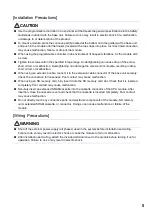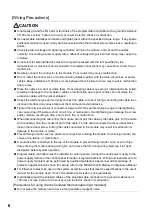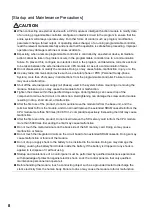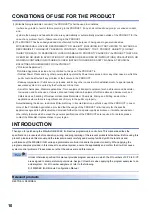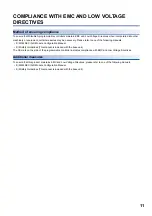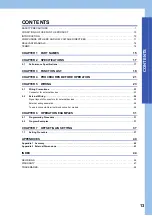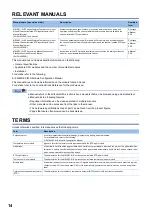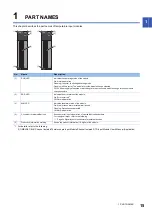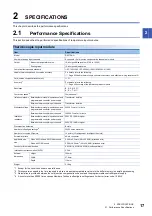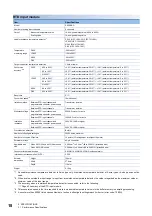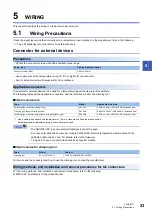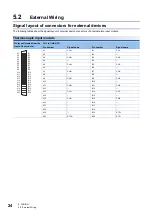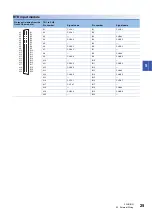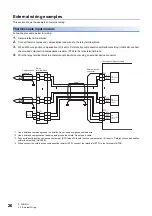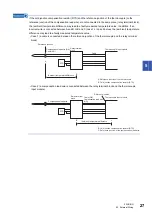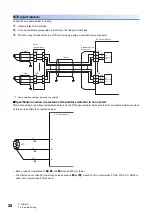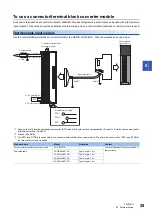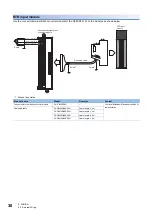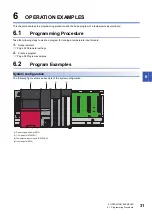
3 FUNCTION LIST
19
3
3
FUNCTION LIST
This chapter lists the functions of temperature input modules. For details on the functions, refer to the following.
MELSEC iQ-R Channel Isolated Thermocouple Input Module/Channel Isolated RTD Input Module User's Manual
(Application)
Item
Description
Input range setting function
Allows to select the thermocouple type or resistance temperature detector type to be used
as well as the input range for each channel.
Conversion enable/disable setting function
Sets whether to enable or disable the temperature conversion for each channel. Disabling
the conversion on unused channels reduces the conversion cycles.
Temperature
conversion method
Sampling processing
Executes the conversion of temperature input values every sampling cycle and stores the
converted values in buffer memory areas as measured temperature values.
Averaging
processing
Time average
Executes the temperature conversion for set time and averages the total value excluding
the maximum value and the minimum value. The calculated value is stored in the buffer
memory area. The number of processing times within the set time varies depending on
the number of channels where the conversion is enabled.
Count average
Executes the temperature conversion for a set number of times and averages the total
value excluding the maximum value and the minimum value. The calculated value is
stored in the buffer memory area. The time taken to store the average value obtained by
the processing in the buffer memory area varies depending on the number of channels
where the conversion is enabled.
Moving average
Averages measured temperature values taken at every sampling cycle for a specified
number of times, and stores the averaged value in the buffer memory area. Because the
target range for averaging processing is moved in response to every sampling
processing, the latest measured temperature value can be obtained.
Primary delay filter
Performs the conversion where the transient noise of temperature input is smoothed
depending on the set time constant. The smoothed measured temperature value is stored
in the buffer memory area.
Scaling function
Performs scale conversion from a measured temperature value to a value calculated
using the ratio (%) of the set scaling width to the set scaling range. The converted value is
stored in the buffer memory area.
Alert output function
Process alarm
Outputs an alert when a measured temperature value enters the preset alert output
range.
Rate alarm
Outputs an alert when the change of a measured temperature value is equal to or greater
than the rate alarm upper limit value, or equal to or smaller than the rate alarm lower limit
value.
Disconnection detection function
Outputs an alarm when disconnection of a thermocouple, compensation lead wire, or
resistance temperature detector is detected. A measured temperature value to be stored
at the disconnection detection is selected from the following.
• Value just before disconnection
• Upscale
• Downscale
• Any value
Cold junction compensation setting function
Enables two types of cold junction compensation (using a cold junction compensation
resistor or an external method (cooling bath)) by setting whether to use a cold junction
compensation resistor.
Cold junction compensation resistor disconnection detection
function
Outputs an error when disconnection of a cold junction compensation resistor (RTD) is
detected.
Logging function
Logs (records) measured temperature values or scaling values. Data of 1000 points can
be logged for each channel.
Logging read function
Allows to store more than 1000 points of data without stopping logging by transferring the
device data to the file register of the CPU module during logging. This function reduces
the takt time in a test demanding high-speed conversion.
Interrupt function
Executes an interrupt program of the CPU module when an interrupt factor such as alert
output or disconnection is detected.
Error history function
Records up to 16 errors and alarms that occurred in a temperature input module to store
them in the buffer memory areas.
Event history function
Collects occurred errors and alarms, and performed operations in a temperature input
module, and stores them as event information into the CPU module.
Offset/gain setting
Corrects errors in measured temperature values.
Backing up, saving, and restoring offset/gain values
Allows to back up, save, and restore the offset/gain values of the user range setting.
Содержание R60RD8-G
Страница 2: ......
Страница 14: ...12 MEMO ...
Страница 18: ...16 1 PART NAMES MEMO ...
Страница 24: ...22 4 PROCEDURES BEFORE OPERATION MEMO ...
Страница 41: ...7 OFFSET GAIN SETTING 7 1 Setting Procedure 39 7 13 Click Yes button ...
Страница 47: ...I 45 MEMO ...
Страница 51: ......

